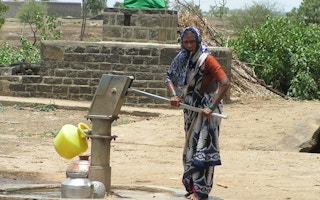It has been a week since senior bureaucrats fanned out over 1,000 districts in India to start projects in water harvesting and water conservation. Meanwhile, the union budget has come and gone with hardly a change in the allocation of the renamed – and presumably strengthened – Jal Shakti (Water Power) ministry.
Now many of the bureaucrats are back in New Delhi, saying what they need is not more money but stricter implementation of existing laws.
Speaking off-the-record, some bureaucrats also mutter about the need to overhaul India’s water-energy-food subsidy structure, while admitting they will not make the “futile” attempt to recommend such an overhaul to their political masters.
The subsidies – free energy, no regulation over groundwater withdrawal and assured prices for water-intensive crops like paddy – brought about the Green Revolution and made India self-sufficient in food grains. But with groundwater levels dipping alarmingly, bankrupt electricity companies and food grain mountains that lead to storage headaches the entire structure is well past its use-by date.
Despite knowing this, politicians are too scared of the big farmer lobby to do anything about it. These represent the interest of those that own farmland of 10 hectares (100,000 square metres) or above, which account for only 1 per cent of all Indian farmers. More than two thirds of Indian farmers own plots of less than 1 hectare (10,000 square metres), and the average size of landholding is 1.15 hectare (11,500 square metres).
Instead, there is now an experiment to pay farmers to save water, being tried in three villages of Punjab by The Energy and Resources Institute (TERI), a think tank based in New Delhi. The farmers are being told that if they use less than a certain amount of water, they will be paid for every litre they save. This, of course, requires a water meter in every farm. Many farmers have refused, as they see it as a sneaky way to install a meter and later charge them for the water they use. A few have agreed. The experiment continues.
The challenge of reviving traditional methods
On a larger scale, the Jal Shakti ministry is now abuzz about the water harvesting mission that Prime Minister Narendra Modi announced in his resumed weekly radio broadcast after regaining power in the April-May election. Suddenly, there are frantic searches for studies, reports and books on traditional water harvesting.
Experts who have so far thought only of the width and depth of irrigation canals are suddenly having to find out how big and how large ponds should be, the best lining for the bottom of a pond, why a stepwell was built the way it was, and so on. Many are exasperated when they find that traditional water harvesting methods change almost every 100 kilometres, and only snort in irritation when told the changes reflect the varied hydrology of South Asia.
There are experts and policymakers who have got their heads around this and have experience of traditional water harvesting systems from the time they were posted at district levels. They do not scoff, but they point to a serious problem – traditional water harvesting requires space.
A pond can be dug only if there is space for it. Natural aquifer recharge as practised traditionally in Rajasthan, and parts of Gujarat and Madhya Pradesh requires strict cleanliness in the watershed – the slope down which rainwater flows before percolating underground.
Since the 1950s, engineers – mostly from the Public Health Engineering departments of state governments – have gone from village to village effectively denigrating these traditional water harvesting methods. They have been saying that surface water gathered in ponds are full of bacteria, or there is simply not enough rainwater to really recharge aquifers. Instead, they have been installing handpumps everywhere to draw underground water, with the promise that this is clean and healthy.
It is now widely recognised that this system has also passed its use-by date. Groundwater levels have been dipping alarmingly in the south, west and north-west of the country. The Ganga and Brahmaputra basins still have groundwater, but over-withdrawal has led to toxic levels of arsenic and fluoride in the water that people use.
So going back to traditional water harvesting is the only way, and there is no shortage of good models to follow.
Mismanaged urban development
But there is a problem. After their initial foray all over India last week, water ministry bureaucrats have reconfirmed that ponds and watersheds have been ruined and encroached upon in village and after village, town after town.
Most of these had been in common lands rather than land belonging to anyone, and once they apparently lost their utility, local musclemen moved in. In the last five decades, Chennai – still facing a crippling water scarcity – has lost over 70 per cent of its tanks. The situation is similar in just about every urban and rural part of India.
The Modi government has promised piped water to every rural Indian household by 2024. To get anywhere near that goal, it will have to take on the encroachers, with all their political connections. In many cases, it will find government offices built on such land. It remains to be seen what the government will do about it.
Will the nearly-static budget allocation to the Jal Shakti ministry hinder these efforts? “The Prime Minister has said this has to be a peoples’ movement, and our minister has said a peoples’ movement does not need money, it needs people,” a bureaucrat wryly points out.
This story was published with permission from The Third Pole.










